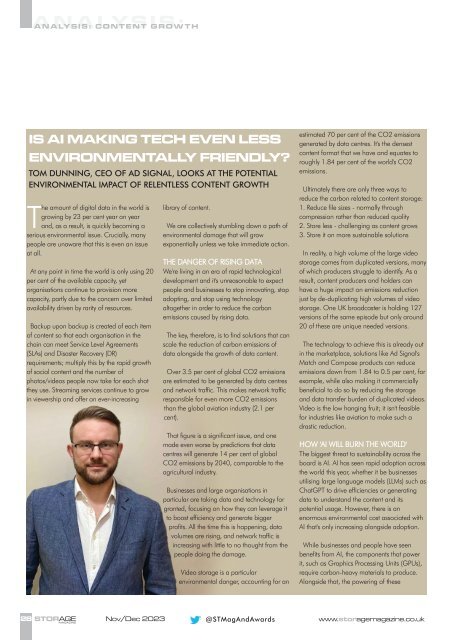ST Nov-Dec 2023
Create successful ePaper yourself
Turn your PDF publications into a flip-book with our unique Google optimized e-Paper software.
Adsignal 28.qxd 01-<strong>Dec</strong>-23 11:05 AM Page 2<br />
ANALYSIS:<br />
ANALYSIS: CONTENT GROWTH<br />
af<br />
IS AI MAKING TECH EVEN LESS<br />
ENVIRONMENTALLY FRIENDLY?<br />
TOM DUNNING, CEO OF AD SIGNAL, LOOKS AT THE POTENTIAL<br />
ENVIRONMENTAL IMPACT OF RELENTLESS CONTENT GROWTH<br />
The amount of digital data in the world is<br />
growing by 23 per cent year on year<br />
and, as a result, is quickly becoming a<br />
serious environmental issue. Crucially, many<br />
people are unaware that this is even an issue<br />
at all.<br />
At any point in time the world is only using 20<br />
per cent of the available capacity, yet<br />
organisations continue to provision more<br />
capacity, partly due to the concern over limited<br />
availability driven by rarity of resources.<br />
Backup upon backup is created of each item<br />
of content so that each organisation in the<br />
chain can meet Service Level Agreements<br />
(SLAs) and Disaster Recovery (DR)<br />
requirements; multiply this by the rapid growth<br />
of social content and the number of<br />
photos/videos people now take for each shot<br />
they use. Streaming services continue to grow<br />
in viewership and offer an ever-increasing<br />
library of content.<br />
We are collectively stumbling down a path of<br />
environmental damage that will grow<br />
exponentially unless we take immediate action.<br />
THE DANGER OF RISING DATA<br />
We're living in an era of rapid technological<br />
development and it's unreasonable to expect<br />
people and businesses to stop innovating, stop<br />
adopting, and stop using technology<br />
altogether in order to reduce the carbon<br />
emissions caused by rising data.<br />
The key, therefore, is to find solutions that can<br />
scale the reduction of carbon emissions of<br />
data alongside the growth of data content.<br />
Over 3.5 per cent of global CO2 emissions<br />
are estimated to be generated by data centres<br />
and network traffic. This makes network traffic<br />
responsible for even more CO2 emissions<br />
than the global aviation industry (2.1 per<br />
cent).<br />
That figure is a significant issue, and one<br />
made even worse by predictions that data<br />
centres will generate 14 per cent of global<br />
CO2 emissions by 2040, comparable to the<br />
agricultural industry.<br />
Businesses and large organisations in<br />
particular are taking data and technology for<br />
granted, focusing on how they can leverage it<br />
to boost efficiency and generate bigger<br />
profits. All the time this is happening, data<br />
volumes are rising, and network traffic is<br />
increasing with little to no thought from the<br />
people doing the damage.<br />
Video storage is a particular<br />
environmental danger, accounting for an<br />
estimated 70 per cent of the CO2 emissions<br />
generated by data centres. It's the densest<br />
content format that we have and equates to<br />
roughly 1.84 per cent of the world's CO2<br />
emissions.<br />
Ultimately there are only three ways to<br />
reduce the carbon related to content storage:<br />
1. Reduce file sizes - normally through<br />
compression rather than reduced quality<br />
2. Store less - challenging as content grows<br />
3. Store it on more sustainable solutions<br />
In reality, a high volume of the large video<br />
storage comes from duplicated versions, many<br />
of which producers struggle to identify. As a<br />
result, content producers and holders can<br />
have a huge impact on emissions reduction<br />
just by de-duplicating high volumes of video<br />
storage. One UK broadcaster is holding 127<br />
versions of the same episode but only around<br />
20 of these are unique needed versions.<br />
The technology to achieve this is already out<br />
in the marketplace, solutions like Ad Signal's<br />
Match and Compose products can reduce<br />
emissions down from 1.84 to 0.5 per cent, for<br />
example, while also making it commercially<br />
beneficial to do so by reducing the storage<br />
and data transfer burden of duplicated videos.<br />
Video is the low hanging fruit; it isn't feasible<br />
for industries like aviation to make such a<br />
drastic reduction.<br />
HOW 'AI WILL BURN THE WORLD'<br />
The biggest threat to sustainability across the<br />
board is AI. AI has seen rapid adoption across<br />
the world this year, whether it be businesses<br />
utilising large language models (LLMs) such as<br />
ChatGPT to drive efficiencies or generating<br />
data to understand the content and its<br />
potential usage. However, there is an<br />
enormous environmental cost associated with<br />
AI that's only increasing alongside adoption.<br />
While businesses and people have seen<br />
benefits from AI, the components that power<br />
it, such as Graphics Processing Units (GPUs),<br />
require carbon-heavy materials to produce.<br />
Alongside that, the powering of these<br />
28 <strong>ST</strong>ORAGE <strong>Nov</strong>/<strong>Dec</strong> <strong>2023</strong><br />
@<strong>ST</strong>MagAndAwards<br />
www.storagemagazine.co.uk<br />
MAGAZINE

















